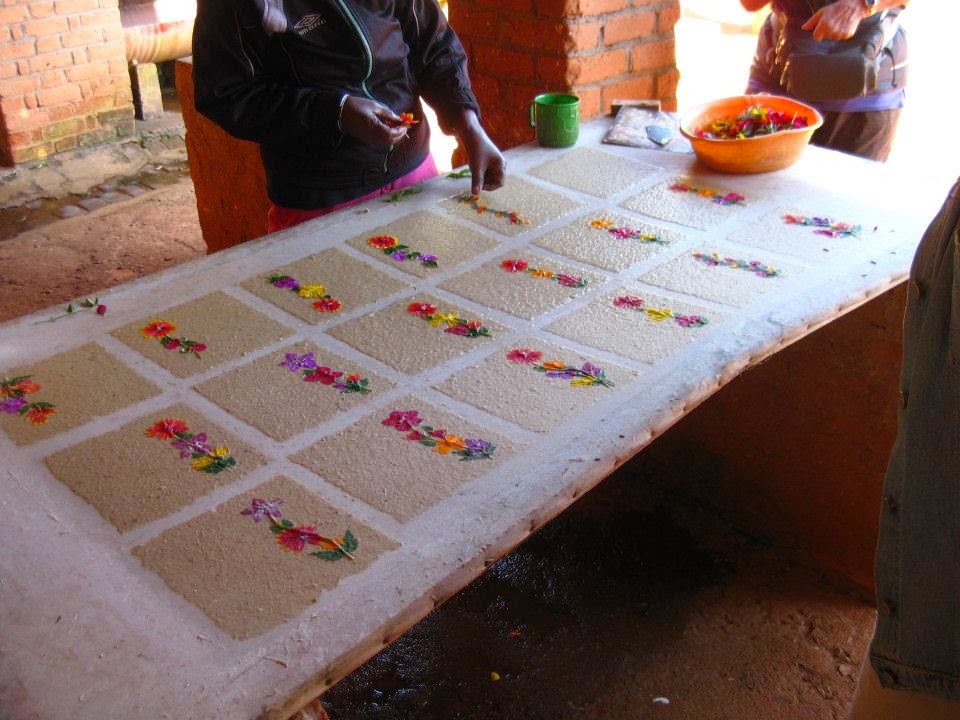But during the very first
days, when I was eager to get to the rainforest, the incessant visits
to local businesses were frustrating. For instance, en route from
Tana to Antsirabe we stopped at a place that produced aluminium pans
in a very primitive way that all Western health-and-safety
authorities would immediately close down: no gloves, no shoes, no
goggles. We all were still green and naïve and asked stupid
questions. To the question why they didn't use a more advanced
technique – just slightly more advanced, like using a permanent
mould rather than making a new one for each pan – Mami explained
that this was the tradition: they had done so for generations, and
they didn't want any change. (After a few days of similar experience,
we stopped asking). Yet apparently this was a successful business
because anywhere we went in the following days we saw the pans from
that factory, which Mami proudly pointed out.
They had a small stall
that sold aluminium lemurs and rodents, but they were not
particularly pretty. I don't buy souvenirs for the sake of having
bought souvenirs; I only buy things that I like or know I can give to
someone who would like them. None of the small figures spoke to me, but I was glad to see some other people buying them.
Then there was a shop that
made miniatures from rubbish, which I watched with fascination,
because I could appreciate the ingenuity and skill (I am a miniature maker in my leisure time). I even bought
a miniature bike, so at least that shop made some profit from our
visit. The price was in the range of 50p. Enough for somebody's lunch? Mami cleverly advised me to put it inside a cut-off plastic bottle, and it survived the journey.
The third factory, on the
same day, made all kind of stuff from zebu horn. We had already
learned about the omnipresence of zebu as food, currency and
sacrificial animal. Watching someone make a teaspoon from horn,
bending and polishing it was in itself interesting, but I knew from
experience that they only showed us a tiny bit of the process that
takes much more time and effort. The tools were primitive (no more
questions from us), and the products were fine, but not for me. Yet in each place
at least some of us bought something, which made me feel less guilty.
While the aluminium pans were presumably used by the locals, horn
spoons, boxes, chameleons and baobabs were produced exclusively for
tourists, which made our watching the process awkward and humiliating
for everyone, including Mami. But as already mentioned, I am probably
oversensitive.
The woodcarving shop on
the road from Antsirabe to Ranomafana was disappointing. It was
fascinating to watch an old man making marquetry with primitive,
make-shift tools (no questions asked; but I couldn't help thinking
that I have better tools for my hobby. If it were at all possible, I would like to send some good tools to this shop). However, there was nothing in
the shop that looked enticing, but
again I was glad that some of our companions bought rather expensive, even
by Western measures, marquetry pictures of mountains and baobabs. I
hope that whoever gets them as a gift will like them for whatever
reason.
The rope and
basket-weaving workshop was pathetic, but I enjoyed the papermaking
factory for the same reason I enjoyed the miniature-bike shop: I could
relate to it because I used to make paper myself. They made pulp from bark of a particular local tree;
they boiled it for hours, beat into pulp with wooden mallets, diluted
with water, poured into huge frames to dry. Decorated with dry
flowers, just like I used to do, and made greeting cards, notebooks
and other stuff papermakers do.
I had been looking forward
to woodcarver's, because I have so many beautiful wooden animals from
South Africa, but surprisingly there was nothing that caught my eye.
We also visited a rum
distillery, a weaver's shop, an embroidery shop, a smithy. I don't
know whether these were typical tourist attractions, like I used to
take foreigners to when I was a guide in Russia. If you have been a
guide you can see behind the scenes. Mami was a great guide, but I
knew he was telling us the truth, but not the whole truth.
Mami said that about forty
tourist groups passed all these workshops every day, so even if just
a few foreigners buy something it may feed a family for a week. Most
of these businesses are family ones, so hopefully the whole family
benefits. There are also cooperatives, supported by Western NGOs. The
question remains, are they profitable at all? Or do people toil
elsewhere and only come in when tours are in sight? There are no
tours during monsoon season.
To be continued.




No comments:
Post a Comment